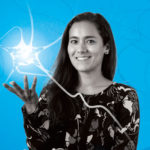Humans can visually distinguish hundreds of thousands of distinct colors and shapes, but how does the brain process all of this information? Scientists previously believed that the visual system initially encoded shape and color with different sets of neurons and then combined them much later. But a study led by Professor Edward Callaway, along with co-first authors Anupam Garg and Peichao Li, has shown that there are neurons that respond selectively to particular combinations of color and shape, findings that provide valuable insight into how visual circuits are connected and organized in the brain.
Read News ReleaseNeuroscience
Salk scientists develop technique to reveal epigenetic features of cells in the brain
Professor Joseph Ecker, Helmsley-Salk Fellow Jesse Dixon, and co-first authors Dong-Sung Lee, Chongyuan Luo and Jingtian Zhou have developed a method to simultaneously analyze how chromosomes, along with their epigenetic features (such as the chemical tags on DNA), are compacted inside of single human brain cells. The work paves the way for a new understanding of how some cells become dysregulated, causing disease.
Read News ReleaseFinding a cause of neurodevelopmental disorders
How mammals’ brains evolved to distinguish odors is nothing to sniff at
The world is filled with millions upon millions of distinct smells, but how mammals’ brains evolved to tell those smells apart is something of a mystery. Now, Salk Distinguished Professor Emeritus Charles Stevens and Shyam Srinivasan from UC San Diego have discovered that at least six types of mammals, including mice and cats, can distinguish odors in roughly the same way, using circuitry in the brain that’s evolutionarily preserved across species. This and future insights on odor coding and the mechanisms for distinguishing odors could be applied to the development of better machine learning or AI systems.
Read News ReleaseHow emotion affects action
During high-stress situations, such as making a goal in soccer, some athletes experience a rapid decline in performance, known as “choking.” Associate Professor Xin Jin and first authors Sho Aoki, Jared Smith and Hao Li have uncovered what might be behind the phenomenon: one-way signals from the brain’s emotion circuit to the movement circuit. The study could lead to new strategies for treating disorders involving disrupted movement, such as depression, along with aiding in improving spinal cord injuries or physical performance under pressure.
Read News ReleaseBrain’s astrocytes play starring role in long-term memory
Professor Terrence Sejnowski, first author António Pinto-Duarte and colleagues have discovered that star-shaped cells called astrocytes help the brain establish long-lasting memories. The new work adds to a growing body of evidence that astrocytes, long considered merely supportive cells, may have more of a leading role in the brain and could inform therapies for disorders in which long-term memory is impaired, such as traumatic brain injury or dementia.
Read News ReleaseScratching the surface of how your brain senses an itch
Light touch plays a critical role in everyday tasks, such as picking up a glass or playing a musical instrument. In addition, it is part of the detection system that has evolved to protect us from biting insects, such as those that cause malaria and Lyme disease, by eliciting a feeling of an itch when an insect lands on our skin. Professor Martyn Goulding, first author David Acton and colleagues have discovered how neurons in the spinal cord help transmit such itch signals to the brain. Their findings have contributed to a better understanding of itch and could lead to new drugs to treat chronic itch, which occurs in such conditions as eczema, diabetes and even some cancers.
Read News ReleaseFeatured Stories
 The Promise and Perils of Big DataSalk scientists are unlocking the power of "big data" to make unprecedented discoveries in neuroscience, cancer and other areas.
The Promise and Perils of Big DataSalk scientists are unlocking the power of "big data" to make unprecedented discoveries in neuroscience, cancer and other areas.
 Joseph Noel – Learning from LagoonsInside Salk sat down with Noel to learn about his path to becoming a scientist and about his current work researching coastal wetlands to help combat climate change.
Joseph Noel – Learning from LagoonsInside Salk sat down with Noel to learn about his path to becoming a scientist and about his current work researching coastal wetlands to help combat climate change.
 Krishna Vadodaria – Uncovering the mysteries of depressionStaff Scientist Krishna Vadodaria's research on human neurons is helping to uncover the biological basis for psychiatric disorders and why some depressed patients do not respond to SSRIs.
Krishna Vadodaria – Uncovering the mysteries of depressionStaff Scientist Krishna Vadodaria's research on human neurons is helping to uncover the biological basis for psychiatric disorders and why some depressed patients do not respond to SSRIs. Corina AntalCorina Antal is not your typical researcher. From wrangling bull sharks to climbing mountains to seeking a cure for pancreatic cancer, Antal follows her passion.
Corina AntalCorina Antal is not your typical researcher. From wrangling bull sharks to climbing mountains to seeking a cure for pancreatic cancer, Antal follows her passion.





















































